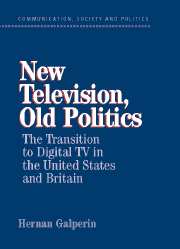Book contents
- Frontmatter
- Contents
- List of Figures and Tables
- Preface and Acknowledgments
- List of Acronyms and Abbreviations
- PART I A POLITICAL ECONOMY OF DIGITAL TV
- PART II THE AMERICAN ROAD TO DIGITAL TV
- PART III THE BRITISH ROAD TO DIGITAL TV
- PART IV NEW TELEVISION, OLD POLITICS
- 12 One Goal, Many Paths
- 13 Explaining National Variations in Digital TV Policies
- 14 Conclusion: The Regulation of Digital Communications and the Resilience of National Regimes
- References
- Index
14 - Conclusion: The Regulation of Digital Communications and the Resilience of National Regimes
from PART IV - NEW TELEVISION, OLD POLITICS
Published online by Cambridge University Press: 24 July 2009
- Frontmatter
- Contents
- List of Figures and Tables
- Preface and Acknowledgments
- List of Acronyms and Abbreviations
- PART I A POLITICAL ECONOMY OF DIGITAL TV
- PART II THE AMERICAN ROAD TO DIGITAL TV
- PART III THE BRITISH ROAD TO DIGITAL TV
- PART IV NEW TELEVISION, OLD POLITICS
- 12 One Goal, Many Paths
- 13 Explaining National Variations in Digital TV Policies
- 14 Conclusion: The Regulation of Digital Communications and the Resilience of National Regimes
- References
- Index
Summary
Questions about who gets what have always been at the center of political analysis. In the communications sector, these questions have implications that go beyond the mere allocation of economic rents, because the distribution of control over a nation's communication resources affects the patterns of knowledge production and dissemination as well as the character of its political life. This is why telecommunications, broadcasting, and other media have typically been subject to much closer regulatory scrutiny than other economic activities. Even in liberal democracies, the role of the state in the communications sector has typically gone beyond the organization of buying and selling between market actors. Public service broadcasting serves as an example, but so does the American model whereby, according to the statute, commercial licensees are selected on the basis of their capacity to serve as public trustees. In one way or another, every nation has devised a television regime that balances self-regulating markets with administrative control to determine who gets to broadcast what to whom and under what conditions. The reason is apparent: the organization of the communications sector determines who can participate in the market for political loyalties (Price, 2002). Therefore, policymakers have designed mechanisms to manage it. Although these mechanisms have varied in time and across nations, the reality is that the shape of a nation's media sector has rarely been left to markets alone. The variations in the broadcasting system across nations reflect historical differences in such mechanisms.
- Type
- Chapter
- Information
- New Television, Old PoliticsThe Transition to Digital TV in the United States and Britain, pp. 272 - 288Publisher: Cambridge University PressPrint publication year: 2004

